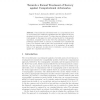Free Online Productivity Tools
i2Speak
i2Symbol
i2OCR
iTex2Img
iWeb2Print
iWeb2Shot
i2Type
iPdf2Split
iPdf2Merge
i2Bopomofo
i2Arabic
i2Style
i2Image
i2PDF
iLatex2Rtf
Sci2ools
GC
2004
Springer
2004
Springer
Towards a Formal Treatment of Secrecy Against Computational Adversaries
Polynomial time adversaries based on a computational view of cryptography have additional capabilities that the classical Dolev-Yao adversary model does not include. To relate these two different models of cryptography, in this paper we enrich a formal model for cryptographic expressions, originally based on the Dolev-Yao assumptions, with computational aspects based on notions of probability and computational power. The obtained result is that if the cryptosystem is robust enough, then the two adversary models turn out to be equivalent. As an application of our approach, we show how to determine a secrecy property against the computational adversary.
Adversary Models | Applied Computing | Classical Dolev-yao Adversary | GC 2004 | Polynomial Time Adversaries |
| Added | 01 Jul 2010 |
| Updated | 01 Jul 2010 |
| Type | Conference |
| Year | 2004 |
| Where | GC |
| Authors | Angelo Troina, Alessandro Aldini, Roberto Gorrieri |
Comments (0)

